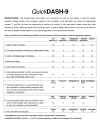A modified QuickDASH-9 provides a valid outcome instrument for upper limb function
- PMID: 20021677
- PMCID: PMC2810294
- DOI: 10.1186/1471-2474-10-161
A modified QuickDASH-9 provides a valid outcome instrument for upper limb function
Abstract
Background: The 30-item Disabilities Arm Shoulder and Hand (DASH) questionnaire was introduced to facilitate assessment of upper limb functional limitations. To improve practicality and eliminate item redundancy a modified instrument was needed. The 11-item QuickDASH was developed to fulfil these requirements and translated into several languages. However, prospective investigations of psychometric and practical characteristics are limited. No published study investigated readability or used concurrent validation with a standardized upper limb criterion measure. The validity of the QuickDASH has been questioned as the results for factor structure are conflicting, and the English-language version has not yet had factor structure reported. A shortened 9-item version, the QuickDASH-9, that addresses these issues is proposed.
Methods: This two-stage observational study assessed the psychometric and practical characteristics of the QuickDASH and the extracted QuickDASH-9. The Upper Limb Functional Index (ULFI) was the criterion standard in both stages. Stage 1, calibration, reanalyzed extracted QuickDASH and QuickDASH-9 responses from a previous prospective study, by the authors, of the 30-item DASH (n = 137). Stage 2, prospective validation, investigated the QuickDASH through repeated measures in consecutive upper limb musculoskeletal participants' consulting for physical therapy in Australia (n = 67). The QuickDASH and extracted QuickDASH-9 data from both stages was analyzed and compared for psychometric properties, practical characteristics and factor structure.
Results: The proposed QuickDASH-9 had a unidimensional structure, high reliability (ICC 2:1, r = 0.92), internal consistency (alpha = 0.93) and responsiveness (ES = 1.05). It correlated highly with both the DASH (r = 0.97), QuickDASH (r = 0.99) and ULFI criterion (r = 0.85). QuickDASH-9 missing responses reduced to 3.5% from 26% in the QuickDASH. Completion and scoring time was 134 +/- 56 seconds and required a computational aid. The QuickDASH demonstrated a bidimensional structure making it invalid. The QuickDASH-9 summary performance was measured on the 'Measurement of Outcome Measures' at 88% and on the 'Bot' clinimetric scale at 75%.
Conclusions: The proposed QuickDASH-9 had a unidimensional structure and similar psychometric precision to the full-length DASH with improved practicality and completion time. The QuickDASH was invalid as its bidimensional structure made a single summated score inappropriate. The QuickDASH-9 offers a future direction for ongoing use of the QuickDASH concept.
Figures
Similar articles
-
Adaptation of the Upper Limb Functional Index (ULFI) to a Polish version and validation in patients with upper limb musculoskeletal disorders.BMC Musculoskelet Disord. 2025 May 23;26(1):506. doi: 10.1186/s12891-025-08758-x. BMC Musculoskelet Disord. 2025. PMID: 40410807 Free PMC article.
-
Modification of the upper limb functional index to a three-point response improves clinimetric properties.J Hand Ther. 2010 Jan-Mar;23(1):41-52. doi: 10.1016/j.jht.2009.09.007. Epub 2009 Dec 5. J Hand Ther. 2010. PMID: 19963344
-
The shortened disabilities of the arm, shoulder and hand questionnaire (QuickDASH): validity and reliability based on responses within the full-length DASH.BMC Musculoskelet Disord. 2006 May 18;7:44. doi: 10.1186/1471-2474-7-44. BMC Musculoskelet Disord. 2006. PMID: 16709254 Free PMC article.
-
Minimal Clinically Important Difference of the Disabilities of the Arm, Shoulder and Hand (DASH) and the Shortened Version of the DASH (QuickDASH) in People With Musculoskeletal Disorders: A Systematic Review and Meta-Analysis.Phys Ther. 2024 May 1;104(5):pzae033. doi: 10.1093/ptj/pzae033. Phys Ther. 2024. PMID: 38438144 Free PMC article.
-
Measuring wrist and hand function: common scales and checklists.Injury. 2011 Mar;42(3):253-8. doi: 10.1016/j.injury.2010.11.050. Epub 2010 Dec 15. Injury. 2011. PMID: 21159335 Review.
Cited by
-
Site-specific Patient-reported Outcome Measures for Hand Conditions: Systematic Review of Development and Psychometric Properties.Plast Reconstr Surg Glob Open. 2019 May 21;7(5):e2256. doi: 10.1097/GOX.0000000000002256. eCollection 2019 May. Plast Reconstr Surg Glob Open. 2019. PMID: 31333975 Free PMC article.
-
Bridge Plate Distraction for Complex Distal Radius Fractures: A Cohort Study and Systematic Review of the Literature.J Wrist Surg. 2023 Jun 28;13(3):282-292. doi: 10.1055/s-0043-1770791. eCollection 2024 Jun. J Wrist Surg. 2023. PMID: 38808186 Free PMC article.
-
Do Patient-Reported Upper-Body Symptoms Predict Breast Cancer-Related Lymphoedema: Results from a Population-Based, Longitudinal Breast Cancer Cohort Study.Cancers (Basel). 2022 Dec 5;14(23):5998. doi: 10.3390/cancers14235998. Cancers (Basel). 2022. PMID: 36497482 Free PMC article.
-
Prognostic Factors Affecting Long-Term Outcomes After Elbow Dislocation: A Longitudinal Cohort Study.J Hand Surg Glob Online. 2021 Sep;3(5):260-265. doi: 10.1016/j.jhsg.2021.05.011. Epub 2021 Jun 24. J Hand Surg Glob Online. 2021. PMID: 34632352 Free PMC article.
-
Construct validity, test-retest reliability, and responsiveness of the Arabic version of the upper limb functional index.BMC Musculoskelet Disord. 2023 Oct 31;24(1):855. doi: 10.1186/s12891-023-06969-8. BMC Musculoskelet Disord. 2023. PMID: 37907914 Free PMC article.
References
-
- Policy on outcome measures and treatment justification. http://www.tac.vic.gov.au/upload/TAC+Physio+Chart.pdf
Publication types
MeSH terms
LinkOut - more resources
Full Text Sources
Medical



